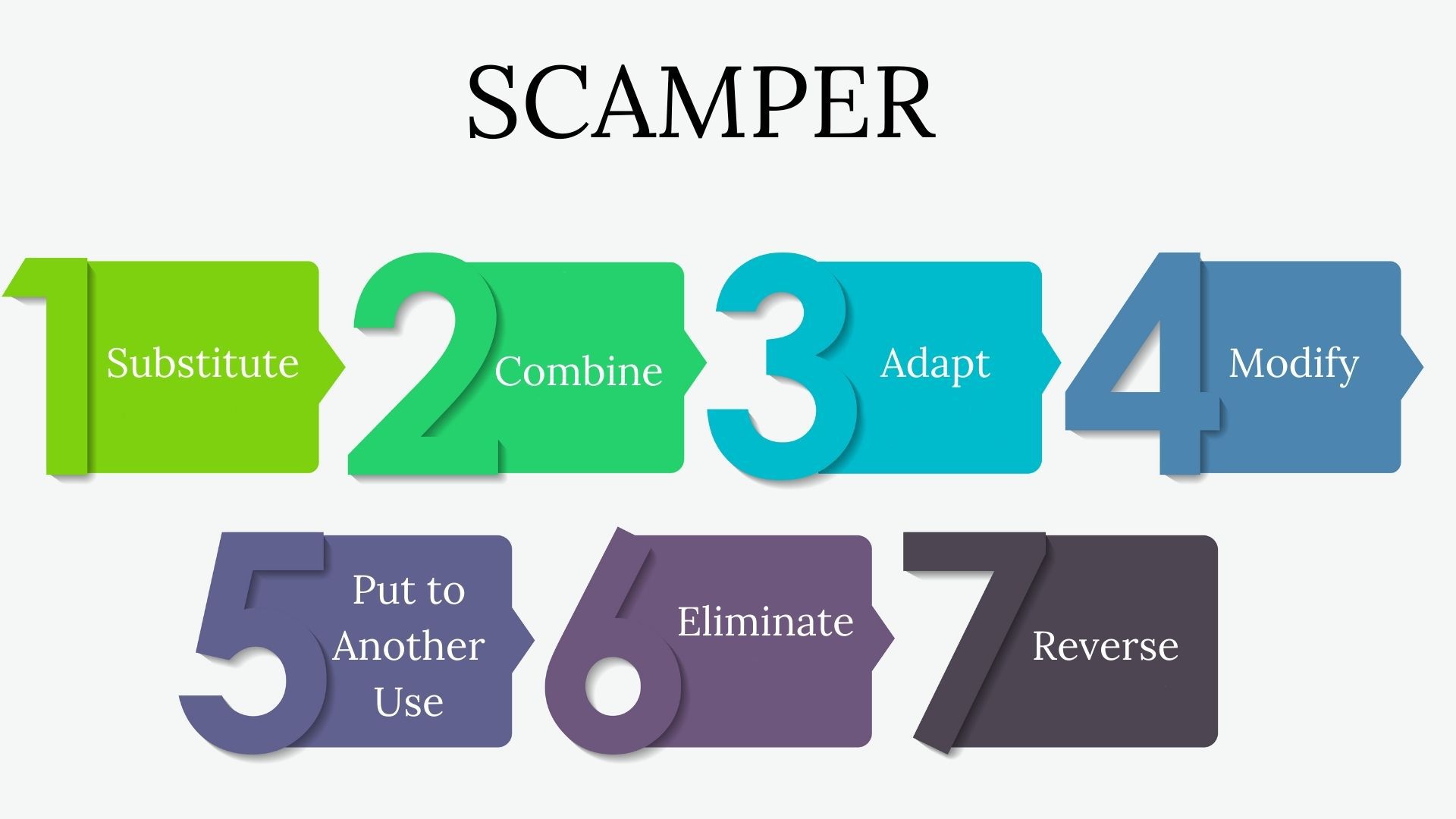As a creativity and idea-generation technique, SCAMPER is an acronym of seven key steps (Substitute, Combine, Adapt, Modify, Put to another use, Eliminate, & Reverse) – useful in generating innovative ideas for improving any specific product or service.
You can opt for the SCAMPER technique for finding the befitting solutions for different challenges you are facing in your personal or professional lives. Turning your ideas into innovation to supercharge your design process, the SCAMPER technique is one of the easiest and direct methods that emphasize the concept that whatever seems new is a modification of old things that are all around us.
In this post, we will dive deep into the world of SCAMPER techniques and understand how they can be used in an effective and result-driven manner. So, without any further ado, let us get started right away-
Table of Contents
Introduction to the SCAMPER Techniques
Every business or every process is often aimed at creating something new.
While designing something new, we all face problems. We all encounter situations wherein it is difficult to develop innovation. Innovation breaks in only when there are difficulties, and we reach a dead end.
In this phase, we need someone who can solve our problems and come up with solutions. What if we had a tool that could help us with all of this? There is a tool like this available in the market, which is called ‘Scamper.’
Let us have a closer look at the acronym ‘SCAMPER’-
What is Scamper?
There are various problem-solving techniques like Hurson’s thinking model, reversed brainstorming, Lego Serious Play, and six hats of critical thinking.
A scamper is a potent tool for promising innovation and creativity. Mr. Bob Eberle created it in the 1970s. This gentleman decided to give problem-solving a new dimension by using general-purpose checklists and some questions.
When one fills these questionnaires, the system provides solutions to these problems. You can improve your services and generate newer ideas through these solutions.
The name Scamper comes from the steps which need to be executed while solving the creative problems in this process.
- S: Substitute
- C: Combine
- A: Adapt
- M: Modify/Magnify
- P: Put to Another Use
- E: Eliminate
- R: Reverse
Role of Scamper in the Creative Processes
Scamper plays a critical role in the solving of simple as well as complex creative problems.
The motive of using Scamper is to make the processes more comfortable and more fruitful. Scamper helps in brainstorming in the right manner for getting the most optimal solutions. It encourages you to improve the existing methods to reduce the wastage of any available resources and make the best use of them. Scamper has gained so much popularity since it is straightforward to use and implement.
If the traditional ways of critical thinking are not that fruitful, one can turn to the modern and novel ways like that of Scamper.
Scamper does not restrict you to only one single format of innovative thinking. It instead lets you move freely among the various forms of problem-solving. It is indeed a creativity-boosting resource. It asks you questions and then deciphers your answers to find the permanent solution.
How Does SCAMPER Solve Your Problems?
Scamper uses seven primary steps to solve any problem. These are the same steps whose initials form the word ‘Scamper.’ Here is a list of them, along with their details.
1. Substitute
We often get stuck with the process of we focus only on specific parts of a process. If we are reluctant to substitute them with some more optimal parts, this part can lead to more issues. There might be unnecessary steps in a process or some unnecessary parts in a machine.
Substitution is the act of replacing the existing part or step with some more efficient and fruitful alternative. This step focuses more on the collective result of the product or the service rather than the importance of individual components.
Some of the question whose answers will help you in optimizing the usability of this step of SCAMPER technique-
Substitute Steps Questions in SCAMPER Technique
- What assets or materials would you be able to substitute for upgrading the item?
- What procedure or item would you be able to use?
- Can you use different materials or fixings?
- Can you change its shading, sound, smell, or harshness?
- Can you change its shape?
- Which rules would you be able to substitute or change?
- Is it conceivable to supplant somebody included?
- Can you use the thought or idea somewhere else?
- What would occur if you altered your demeanor or emotions towards the item?
2. Combine
Sometimes, in a product or a service, many elements are scattered, and this leads to some design issues or flaws. Here, the step of combination comes into the picture. Many creative experts and design experts opine that this is one of the crucial steps in the Scamper tool.
The merging of two innovative ideas to form a more excellent concept leads to a new product or a new technology that will strengthen the value of the brand in the market. There is the utmost need for creativity in this step.
Key questions that should be answered in the Combine step of SCAMPER technique-
Combine Step Questions in SCAMPER Technique
- What parts, thoughts, or materials could be combined?
- What might they be able to be combined with to upgrade usages?
- What could be the consequence of joining the item being referred to with another to create something innovative?
- What could be the consequence of combining targets or purposes?
- How to join assets and the ability to build up another perspective coordinated at the item?
- Can various components be combined to upgrade it?
3. Adapt
There are times when the solutions to most of the problems lie around us. We just need to adapt to these solutions. The most innovative ideas are inspired from the existing ones. The existent ideas are tweaked a little bit to suit modern and newer problems.
Adaption is one of the most decisive steps in the Scamper process. This step helps the newer problems be solved using the older means. The only new thing is the ability to adapt to these means and making the best use of them.
Adapt Step Questions in SCAMPER Technique
- Is there an answer you can take from elsewhere and form it to suit this one?
- Is there closeness between the current circumstance and something different?
- Is there another setting your product setting suits?
- What or who might you be able to mimic to adjust this item to satisfy another sort of utilization or reason?
- What else does the item look like?
- What different thoughts or items would you be able to use for motivation?
- Are there any thoughts outside your field that you can think of?
4. Modify or Magnify
This step is used to magnify the existing problems and try to find out solutions. One can exaggerate the current ideas and find the minutest details of the issues. This lets you study the smallest parts of a problem and find a solution to each of those.
The step of modification is beyond simple adjustments. Hence, this step requires the presence of mind and critical thinking. Even the modifications are made to suit the new problem, and these changes are not forced upon the issue.
Modify questions in SCAMPER Technique
- Can you change a part of your procedure or item to improve it?
- Can you think about any approaches to change the shape, appearance, feel, shading, or type of your item?
- What would you be able to add to change this item?
- What would you be able to feature or accentuate to deliver more worth?
- What part of the item would you be able to make it more rugged to create something new?
Magnify questions in SCAMPER Technique
- Is there anything you can make more significant, higher, or bigger?
- What would you be able to exaggerate or overstate?
- Can you increment the recurrence?
- What would you be able to copy? Is it conceivable to make different duplicates?
- Is it conceivable to incorporate extra highlights or, in any case, include additional worth?
- What would be the result of exaggerating a part?
- Is it conceivable to raise the cost by expanding value?
5. Put to Another Use
If you have an idea, but there are no practical applications or feasibility of it in the current scope, you do not need to trash the design altogether. That same idea can be implemented by some other means in the range of some other problem.
It is called ‘put to another use.’ Sometimes, even a great idea is not realized in the same manner as it envisaged. It can be applied differently, and that helps the problem-solving.
‘Put to Another use Step’ Questions in SCAMPER Technique
- Is it conceivable to use this item somewhere else, possibly in another industry?
- Who else can use this item?
- Would this item work contrastingly in an alternate setting?
- Is it conceivable to reuse the item’s wastes to make something new?
- What else might it be able to be used for?
- How could a youngster or more seasoned individual use it?
- Is it workable for individuals other than the target niche to have the option to utilize it?
- Can you use this thought in an alternative spot?
- Can individuals with different handicaps use it?
- Are there different approaches to use it in its current structure and shape?
- If you knew nothing about it, would you be able to grasp the target of this product?
- Is there some other issue that your item might be an answer for?
- What are the numerous different ways that the item has its usability?
6. Eliminate
In some problems, there are some elements or some useless steps. They might be useful in the past, but now, they might not be that useful. Hence, these steps need to be eliminated.
It is also called the reduction of the problem. This step includes the trimming of processes, ideas, and objects. It gradually narrows down the challenge of the problem, and solving it becomes easier.
Eliminate Step Questions in SCAMPER Technique
- How might you rearrange or smooth out this item?
- What could you downplay or understate?
- What parts can be taken out without disturbing capacity?
- What might supplant the segment/part?
- Is it conceivable to dispense with the standards?
- How would you be able to limit cost, exertion, or time?
- How would you be able to make it lighter, quicker, littler, or more engaging?
- What is pointless or insignificant?
- Should you break it into various parts?
7. Reverse/Rearrange
It is the rearrangement of some elements of the problem to form the solution. In some problems, you just need to rearrange the modules of the already-existing solution or rephrase your thinking process.
Also, you can take a step back and look at the problem with a different perspective. It will open new doors to different solutions. Problem-solving can be made easier using this step.
Would you be able to exchange segments?
Reverse Step Questions in SCAMPER Technique
- Is it possible to interchange components?
- Is it possible to interchange circumstances and logical results?
- Can you transpose negatives and positives?
- Can you exchange the examples or format?
- What other successions, format, or examples would you be able to utilize?
- Can you adjust the timetable of delivery or pace?
- How would you be able to revamp this item?
- Can you adjust the order of steps in your procedure?
- What might another game plan be better?
- What might be the result of the procedure reversal?
- What if you flipped around it?
- How would you be able to switch jobs?
- Can you revise or converse the idea you as of now have?
Final Thoughts!
On the concluding, it is evident that Scamper is a unique and brilliant tool to solve even the toughest of problems and come up with the most intriguing and efficient solutions.
What are your thoughts about its applicability? Do you have some situations where you suggest using the SCAMPER technique? Share with us in the comment section below?
Liked this post? Check out the complete series on Management


